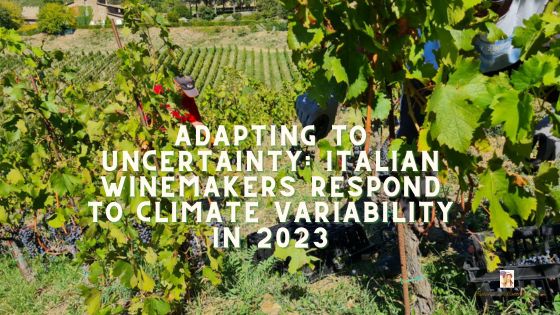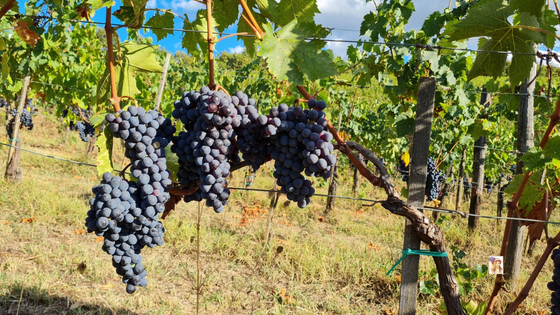
The weather conditions in Italy, as well as worldwide, have been quite challenging in 2023. There have been instances of rain, floods, hailstorms, heatwaves, wildfires, and more. All of these have had adverse effects on this year’s vegetative cycle, leading to various diseases and a loss of production. This year’s harvest has been a sad one for some, while quite acceptable for others. It’s worth noting that there are differences between the northern and southern parts of Italy in terms of the harvest.
According to the Observatory of Assoenologi, Ismea, and Unione Italiana Vini, the overall loss of quantity compared to the previous year is estimated to be 12%. However, in Central and Southern Italy, the losses are expected to range between 20% and 30%.
Daily precipitation from late April to late June caused continuous wetness in the soil and vines, leading to downy mildew in the vineyards. The rain made it difficult for the vineyards to dry, which made it easier for the mildew to attack. Several vintners reported that not only did the treatments “rain away” the day after, but they also couldn’t enter the vineyards due to the wet and muddy soil.
What is Downy Mildew?
Plasmopara viticola is a fungal-like oomycete organism that targets plant foliage and spreads through the air via spores. It causes downy mildew, which primarily affects plants by causing mold-like growth on leaves. This leads to discoloration, leaf curling, and reduced photosynthesis. The pathogen thrives in cool, wet, and humid conditions, and spreads rapidly under such conditions.
To prevent downy mildew, good air circulation is important. However, if the grapevines have already been infected, conventional wineries can use chemical products to treat the vines, while organic wineries can use mainly copper and sulfur. It is important to note that the treatment of foliage requires a significant amount of copper and sulfur, which can have harmful effects on the soil over time. In recent years, researchers have been working on developing vegetal, mineral, and animal-based products for the treatment of downy mildew, such as poltiglia bordolese. For instance, the EU and Italian national action plan for organic agriculture aims to decrease the use of chemical products that have negative impacts on public health and the environment by 2030.
Climate change can to a certain extent influence the prevalence and distribution of downy mildew. Warmer temperatures and altered rainfall patterns may extend the disease’s geographic range, making it an even greater concern for Italian vineyards. In 2011, researchers at the US National Center for Biotechnology Information carried out a study where they showed how there was an increased occurrence of downy mildew with higher CO2 and temperatures.
The rise in global temperature, triggered by the surge of CO2 and other greenhouse gases, could give pathogens more time to evolve. This could have an indirect impact on the survival of downy and powdery mildew on vines.

The Situation at Fattoria di Montemaggio in 2023
According to Ilaria Anichini, the Estate Manager at Fattoria di Montemaggio, they have faced some problems with downy mildew, but the losses are not overwhelming. She emphasizes that they had an early flowering of the Sangiovese with a quick fruit set, which she believes has helped reduce the attack of downy mildew. Additionally, they kept an extra cluster on the vines to mitigate the impact of the disease.
“We have damages and a reduction of production of Sangiovese but despite this, I am not too worried,” says Ilaria Anichini. The infection has been much more widespread in the other grape varieties. When it comes to Merlot, the situation is more dire just as for many wine producers in Italy. The flowering period of Merlot is early while the fruit set occurs in the average period for the development of the fruit. This allowed for a longer period for the downy mildew to infect the plants. At Capezzana winery in Carmignano, they commented the other day on how it indeed will be difficult to find Merlot grapes this year.
Ilaria Anichini underlines that difficult years are a part of being a farmer and it does not mean that the wine will be bad. On the contrary, the wine producers might have suffered larger damages and spent more on treatments for the disease, she continues, but the grapes that are harvested in 2023 will be of excellent quality.
The Economic Effects…
The reduced harvest of 2023 due to downy mildew, flooding, wildfires, and other challenging conditions will surely have an economic impact on most wine producers. The increased costs for disease management do not help either. The Italian government has allocated 1 million euros to Ismea (the Italian Institute for Services to the Agricultural Food Market) via the law decree Asseet to support wineries and vine growers affected. Support will also be allocated by the Fondo di solidarietà Nazionale (the National Solidarity Fund) for the climate challenges suffered by the agricultural and viticultural sectors. Each harvest is different and it is the essence of producing quality vintage wines, but sometimes it can be challenging for wineries and vignerons to make ends meet.
We are confident the wine will be of excellent quality this year, even if the bottles produced will be fewer.
Written by Katarina Andersson.






Leave a Reply